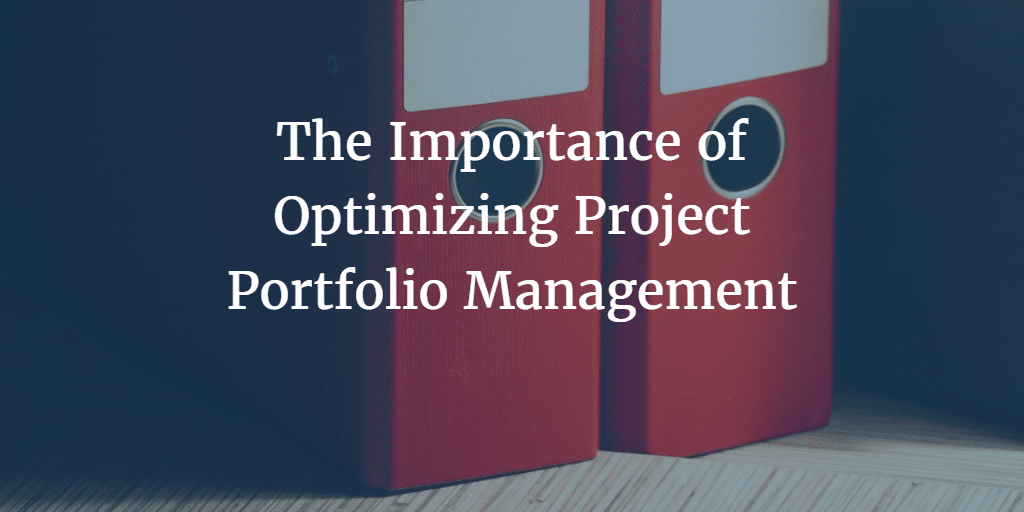Project management is one of the biggest differences between well-run, sustainable companies and those that fail. The right application of project management tools leads to optimal use of resources and time, along with the ability to forecast future results and prepare for a wide range of circumstances. Project portfolio management, in turn, is a type of project management that combines all needs and processes for ongoing projects into a single clearinghouse for resources. PPM uses a company’s total resource input to most efficiently complete all ongoing projects according to their current and future needs. This is in contrast to managing each project separately, which can cause duplication of effort, misallocation, and other problems. In this post, we will discuss project portfolio management and describe how it can benefit a company relative to using basic project management.
Intro to Project Portfolio Management
The key insight behind project portfolio management is to treat the work the company does as one unified portfolio made of up several projects, rather than separate initiatives with separate goals. The essence of PPM is centralizing management of multiple, or even all current projects under a single umbrella. Each individual project is likely to involve some similar resources, and it is also possible that some work groups will be carrying out similar tasks. One project might be able to make use of a tool that another project created for themselves earlier in the year. Two projects could need the same critical resource, so it would cause delays if they both reached that stage at the same time.
All of these examples illustrate how coordinating at a level a step above the project can permit powerful synergies and coordinated efforts. The project portfolio viewpoint is to treat each project as one investment out of many. This approach lends itself well to organizing the entire company to avoid redundancy or shortages. This difference between PPM and project management is similar to the difference between strategy and tactics. One is a grand, overarching plan and the other is a set of specific instructions for individuals. Project portfolio management does not replace project management; it supplements the lower guidance instead. Project managers on each project and team are still important because they help employees execute the plan and report progress, setbacks, and advances to the central administration. In fact, under PPM mid-level project managers are more important than ever because they are the key link between the workers and the planners.
Why Use Project Portfolio Management
The advantages of building a PPM system are several. First of all, the system combines data from many inputs to help determine the best use of resources by the company. Human managers at each project will tend to overestimate how much that project will need. Moreover, they won’t consider the needs of other projects. PPM software can help managers see how each project is moving along and what it is consuming relative to the planned budget. Collecting the data directly also has numerous side benefits. It can help the upper management see how well their previous forecasts of costs and timing performed, for example, so they can improve their ability to predict future expenditures. That can shape many future decisions, from what to make and how much to make to what types of contracts to write with suppliers and retailers. In a way PPM offers an internal use for Big Data, depending on how much information is available and how useful it is. This data can even inform future product development by creating an example for what each part takes to make in terms of time and other inputs.
Next, PPM promotes efficiency. Today’s marketplace is cutthroat. Even if you do not have a strong competitor now, the lure of profits will attract rivals sooner or later. Often they will attempt to disrupt the industry with unconventional business models or pricing strategies. Keeping up with that kind of threat takes everything the company has and it cannot make any mistakes about misusing any resource. For example, if two different projects need the same input it makes sense to acquire and distribute it centrally, instead of having two separate entities work with it individually. This might be a physical good like steel or it could be something as simple as worker time. If a worker feels that they are not being used properly it hurts morale. It is also generally a poor use of time. PPM can use a system of reminders to emphasize due dates or other important moments to ensure that the right resources go to the right teams at the right time. There could also be cost savings if the company, for example, can buy two projects’ worth of inputs from a single vendor for a bulk discount, even if one of the projects does not need that input yet. Moreover, when problems arise within a project, it’s the PPM team that can determine the severity of the problem and what the best response would be that avoids disrupting other projects as much as possible.
PPM is also critical for ensuring that the company strategy is on track. It is not enough to just start a few projects with no vision behind them. Project portfolio management shows the upper levels how each individual project contributes to the company and how it might lead into the next stage. Again, this is not something that a project manager at those projects would be able to see on their own. It is simply too difficult to escape the viewpoint of being inside a project. Ideally each project will have a range of possible good outcomes, from finishing the design and deployment of a new product to installing better sales software. Each should complement and build on the others to multiple growth opportunities and establish a core vision. Without that ability to see it all from above and look to the future, it’s very hard to prioritize different parts of different projects or see how each one matters to the bottom line.
PPM can help catch small inefficiencies that may have been ongoing for years. Redundant workers, missing materials, traffic problems– all of these slow projects down. A mature project portfolio management scheme is able to adapt to all of these and minimize their impact. That can take the form of reacting in the moment, planning in advance, and both. Smoothing out these wrinkles can have a large overall effect because the savings will go right back to the team. This ties back into the point about the competition. Success in the market depends on staying efficient and agile. A big part of that is navigating the small setbacks that litter a project’s path without getting distracted or slowed down.
How To Implement Project Portfolio Management
The first stage of moving to a PPM system is convincing all stakeholders that the change is good. Many will be resistant. It will seem as if implementing PPM is a threat to their jobs or, at least, their responsibilities. It will be necessary to explain why this is not the case. Emphasize the important role that managers play as liaisons between the data and the system on one side and the workers on the other. In addition to that, there will be natural reluctance to make a significant management change. Especially for older companies, most workers and managers will prefer to keep things the way they are because they have delivered success time and time again. Any move is potentially a move away from what works and towards an unproven new system that will cause headaches. It is also impossible to ignore the real monetary costs of making such a change. From the cost of software and training to potentially hiring new staff, the expenses can add up, and that will draw some negative attention because it has not yet shown its worth. PPM is also not easy to demonstrate on a trial basis because it needs to draw from so many projects for enough time to work.
Once everyone is onboard, the next stages are relatively easy. Depending on the PPM solution or solutions that the company is using, there should be a clear set of instructions for connecting software to data sources and building analytical tools. Make sure that whatever software you get is compatible with the products you already use. It would be a waste if you found out that your software could not read in the data from your projects.
The philosophy of portfolio management is at its core an interplay between one or more production processes and a set of constraints, like customer demands, cost requirements, and limited resources. This is a problem that businesses have to solve on a daily basis. Using PPM software and a dedicated PPM team simply makes that consideration explicit.
Financing and Risk
Perhaps one of the less appreciated applications of project portfolio management is the effect it has on the company’s ability to finance projects and assess its own risk. Because the company’s ability to borrow and raise money is a function of the entire company’s reputation and previous financial standing, it makes sense to make financing decisions at the portfolio level. A new project getting off the ground might need an influx of cash, while an older project is nearing completion. Without PPM the new project’s managers might push for financing without fruitful result, because the company appears overleveraged. With PPM, the team can point out that the old project is soon to start bringing in revenue and loans that financed it are not the same as new loans to kick off a new project. While each project spends money on its own, they all have to draw on the financial resources of the company as a whole, so their needs are closely linked and jointly affect the company’s financial posture.
Coordination and Synergy
Aside from the basics of moving around money, inputs, and workers to get work done, PPM can also have broader benefits. First of all, it makes companies more resilient and agile in their responses to emergencies. It is much easier to redirect needed resources in an emergency from a higher level of management. During such events a quick response is essential for successful resolution of the problem. A portfolio management team will have a clear understanding, through experience, of what each project needs to survive an emergency and what they can afford to temporarily lend to other projects.
Within each project, work groups and teams wind up creating shortcuts and best practices for accomplishing their specific tasks. Often these have wider applications, but go unshared because the individual group does not see and understand how others could benefit from their discoveries. Portfolio management staff will know which work groups across different projects are similar to each other and will keep an eye on these similar groups to see when any of them has a breakthrough. That will enable them to spread new ideas across the company quickly so everyone can benefit.
Optimal Funding
Perhaps the most important and difficult task facing portfolio management is the process of choosing which projects get the approval and funding to continue and which do not. The staff has the luxury of understanding the entire pipeline of the company, so they will know the needs and expenses of all other pending projects. Making joint decisions avoid jams and conflict over limited resources or accidental cash crunches as multiple projects enter high-spend phases. This requires truly detailed data on each project and proposal as well as accurate forecasts of the company’s state in the next several months to years. It is daunting, but the rewards of optimal funding are enormous. Poorly times over-extension and over-expansion is a significant threat to companies in every field. They can stretch the resources too thin before any of the payout arrives, leaving the company with no money but months away from increased revenue generation. That is a deadly position to be in, but PPM can help the company see it coming and time its projects to ensure a smooth pipeline.
Even the best plans can go awry, but here a PPM system is also the best solution for growth. Aside from outright emergencies, the PPM staff has the knowledge to see when a project in need can borrow resources from a different one without compromising either. Good project management doesn’t mean choosing the order in which to fund projects and then sticking to the plan no matter what. It means being flexible enough and having enough foresight to intelligently redirect resources along the way.The bottom line is that project portfolio management is only becoming more popular and accessible due to all of the benefits it brings. Increasingly cheap and powerful software makes the transition to PPM easier and lessens the staffing burden for learning how the system works and implementing it. Not every company will make good use of PPM. For example, a newer or smaller firm that tends to only have one project at a time will not benefit from a portfolio approach because it essentially has no portfolio. But in general the upside gets bigger the larger and more complex the company structure is. That is because PPM can provide top-down guidance with specificity and precision.
Most of the costs of PPM are up front, like the cost of software, training, hiring, and the time it takes to learn and understand the system. On the other hand, the benefits tend to be stretched out over multiple product cycles. That can make it hard for managers and executives to evaluate whether PPM is right for their company. The truth is that it is a suite of powerful tools that has varied positive upsides on multiple aspects of planning and management. At the very least, that makes portfolio management worth a look, and at best it could revolutionize the entire workflow of a company.






